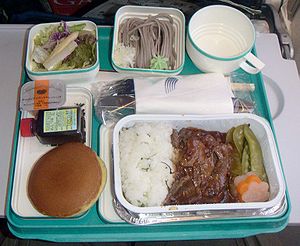Airline meal
This article needs additional citations for verification. (April 2008) |

An airline meal or In-flight meal is a meal served to passengers onboard a commercial airliner. These meals are prepared by airline catering services.
The first kitchens for serving meals in flight were established by United Airlines in 1936.
These meals vary widely in quality and quantity across different airline companies and classes of travel. They range from a simple beverage in short-haul economy class to a seven-course gourmet meal in long-haul first class.
Contents
The type of food varies depending upon the airline company and class of travel. Meals may be served as "one tray" or in multiple courses with no tray and with a tablecloth, metal cutlery, and glassware (as in first and business classes).
The airline dinner typically includes meat (most commonly chicken or beef), a salad or vegetable, a small roll, and a dessert.
Caterers usually produce alternative meals, e.g., kosher, halal and vegetarian. These must usually be ordered in advance, sometimes when buying the ticket. Some airlines do not offer a specific meal for vegetarians; instead, they are given a vegan meal. Some of other special meals include:
- Cultural diet, such as Chinese, French, Japanese, Indian, or Italian style.
- Infant and baby meals.
- Medical diet which varies from low/high fiber, low fat/cholesterol, diabetic, peanut free, non-lactose, low salt/sodium, low-purine, low-calorie, low-protein, bland to gluten-free.
- Religious diet, such as Hindu, Muslim or Buddhist (i.e., Asian vegetarian) diet. Halal and Kosher are included in this.
- Children's meals, which often contain foods that picky children will enjoy such as baked beans, mini-hamburgers and hot dogs.
Cutlery

Before the September 11th attacks in 2001, first-class passengers were often provided with full sets of metal cutlery. Afterward, common household items were evaluated more closely for their potential use as weapons on aircraft, and both first class and coach class passengers were restricted to plastic utensils. This restriction has now been relaxed in many countries.
Other non-food items
Condiments (typically salt, pepper, and sugar) are supplied in small sachets. For sanitation, most meals include a napkin and a wet wipe (also called a moist towelette), often moistened with scented water. First and business class passengers are often provided with hot towels, proper salt and pepper shakers, and other items typically seen in a restaurant.
Breakfast

During morning flights, a smaller, continental-style or "hot" breakfast may be served instead. For the continental-style breakfast, this may include a miniature box of breakfast cereal, cut fruits, a muffin or pastry, or a bagel. Some airlines offer the choice of "hot" breakfast meals to the passengers (usually on long haul flights, or short/medium haul flights within Asia), which normally include an entrée of pancakes or eggs, traditional fried breakfast foods such as sausages and grilled tomatoes, and there are often muffins or pastry, fruits and breakfast cereal on the side. Coffee and tea are offered as well, and sometimes hot chocolate.
Quality

Prices charged to the passengers for food on board the flight ranges in price from free (many airlines, especially those in Asia and all airlines on long haul flights offer free meals) to as much as ten dollars (Midwest Airlines). Quality may also fluctuate due to shifts in the economics of the airline industry, with private jet passengers receiving the equivalent of five-star food service.[1]
On the longest flights in first class and business class, most Asian and European airlines serve multicourse gourmet meals, while airlines based in the US tend to serve large, hearty, meals including a salad, steak or chicken, potatoes, and ice cream. Some long-haul flights in first class (from mostly Asian carriers) offer such delicacies as caviar, fine Champagne, and even sorbet (in-between courses). The cost and availability of meals on US airlines has changed considerably in recent years, as financial pressures have inspired some airlines to either begin charging for meals or abandon them altogether in favor of small snacks(Southwest Airlines). Eliminating free pretzels saved Northwest $2 million annually. The carrier lost nearly $3.3 billion since 2001.
Taste

Meals must generally be frozen and heated on the ground before takeoff, rather than prepared fresh. Guillaume de Syon, a history professor at Albright College who wrote about the history of airline meals, said that the higher altitudes alter the taste of the food and the function of the taste buds; according to de Syon the food may taste "dry and flavorless" as a result of the pressurization and passengers, feeling thirsty due to pressurization, many drink alcohol when they ought to drink water.[2]
Food safety
Food safety is paramount in the airline catering industry. A case of mass food poisoning amongst the passengers on an airliner could have disastrous consequences. For example, on February 20, 1992, shrimp tainted with cholera was served on Aerolíneas Argentinas Flight 386. An elderly passenger died and other passengers fell ill.
Technical crew meals

Food safety with technical crew meals (pilots and flight engineers) is sometimes even stricter than for passengers. Many foodstuffs are banned completely from crew meals, including all egg products and often any dairy that has not been ultra-heat treated. The meals supplied on some airlines are labeled with the position of the crew member for whom they are intended, and no technical crew member eats any of the same products as his or her colleague.[citation needed] This ensures that each pilot eats a different meal to minimize the risk of all pilots on board being ill.
See also
References
External links
- In-flight food fight - MSNBC
- Airline meal photos by carrier (Dormant site - Last updated 2006, as of February 2009)
